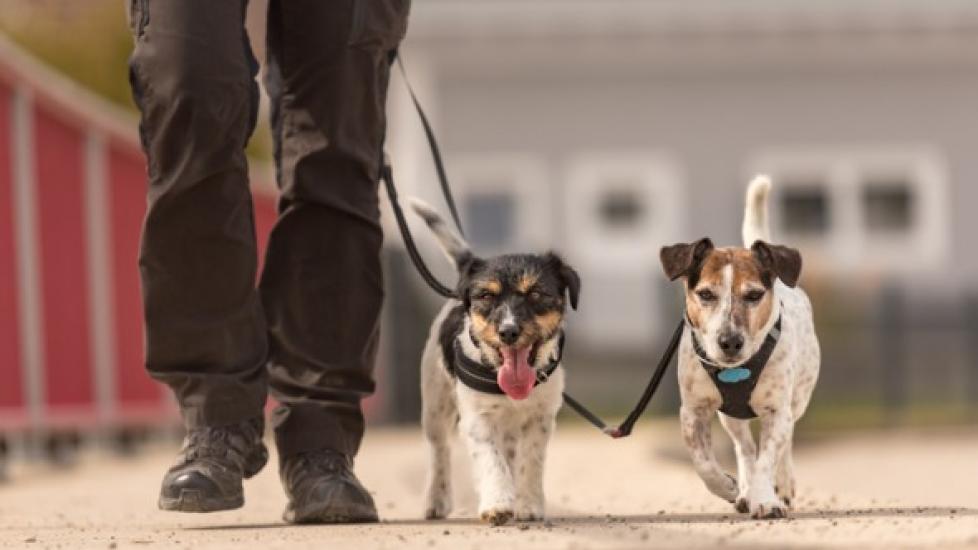How to Choose and Fit a No-Pull Dog Harness
No-pull dog harnesses offer a gentle way to manage dogs that pull while on a lead. But because there are so many different dog harness options available, trying to select the perfect one for your pulling pooch can be overwhelming.
Whether you’re dealing with a dog that’s been pulling for years or you’re leash training a puppy, a no-pull harness can help both you and your dog find a more comfortable way to walk together.
Management vs. Leash Training a Dog to Stop Pulling
A no-pull dog harness can dramatically lessen the strain of a dog pulling on the leash by managing the behavior, but it won’t train your dog to stop pulling. When you remove the no-pull harness, it’s likely your dog will go back to dragging you down the street.
While many pet parents don’t mind relying on a management tool to decrease pulling, if you want to truly get rid of “sled dog” behavior, you’ll have to work on positive reinforcement leash training in conjunction with using a no-pull harness.
How Can a No-Pull Harness Help?
Dogs of all shapes and sizes pull on the leash. Even though a pulling Papillion doesn’t have the same drag strength as a pulling Pit Bull, both types of dogs can benefit from wearing no-pull harnesses. A properly fit harness can prevent neck strain and other health concerns associated with long-term pulling while wearing a dog collar.
Before you begin shopping for a no-pull harness, remember that not every harness decreases pulling. No-pull harnesses for dogs are specifically designed to inhibit pulling, either because of where the dog leash attaches to it, or because of the sensation of the straps that go around the legs or torso.
Find the No-Pull Harness That Works Best for Your Dog’s Size
That said, the range of intervention within no-pull harness options varies. For example, a smaller dog with a pulling habit could probably benefit from a simple front-clasp harness, like the Frisco padded front lead dog harness. This comfort-fit harness gently redirects pulling by reorienting the dog to the handler when she starts to pull.
A larger dog with a longstanding pulling habit would likely do well in a Sporn non-pull mesh dog harness, which humanely curbs moderate to heavy pullers. The veterinarian-approved design decreases pulling through the sensation of the padded restraints under the dog’s front legs.
There is no single harness that works for every dog because of the variety of canine body types. Some harnesses might not be comfortable for a dog with an extra-wide head or long, slender body, so consider your dog’s unique shape when shopping.
Ensuring a Great Fit
No-pull harness sizing varies by manufacturer, so rather than assuming your Labrador is a large and not an extra-large, it’s best to follow the sizing guide for each harness type.
To get a perfect fit, most harnesses require a girth measurement, which is the circumference of the widest part of your dog’s body, right behind his front legs. Sturdy harnesses for oversized pullers, like the HDP Big Dog no pull dog harness, also need a lower neck measurement, which is the part that’s just below where a typical collar sits.
Some harnesses also use a chest width measurement, which is the space across your dog’s chest. It’s easiest to take these dimensions using measuring tape, but you can also mark a piece of string or your dog’s leash and then place it against a ruler.
How to Put on a Dog Harness
No matter what type of no-pull harness you select, give your dog the opportunity to acclimate to it. If the harness has several adjustment points that ensure a precise fit, like the PetSafe Easy Walk dog harness, adjust the straps to your dog’s approximate size before you put it on her.
Trying to do the initial fitting while your dog is wearing the harness might make her fidgety. Make sure to check for potential tight spots around your dog’s underarms that could lead to chafing.
It also helps to pair the initial introduction to the no-pull harness with dog treats so your dog understands that wearing it is a positive experience. If the harness slides over your dog’s head like the Chai's Choice 3M reflective dog harness, use a larger, chewy treat to encourage your dog to feel comfortable with the process. Hold the treat just inside the neck piece so that your dog willingly puts her head inside to eat it.
Remember to give your dog treats as you set off on your first no-pull harness walk so that the experience is pleasurable for you and your dog.
Image via iStock.com/KThalhofer
